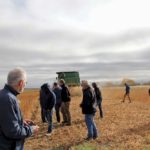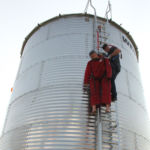
They do things differently there
Reporter’s Notebook: In Quebec, membership in the agriculture lobby group UPS is mandatory for farmers

PHOTOS: Helping with the harvest
Soybeans grown on the Ag in Motion site harvested for the Foodgrains Bank

Developing resistance: Group 2 herbicides
Each herbicide group kills weeds differently. Weed resistance differs by herbicide group

Managing fungicide resistance
Your risk of resistance will depend on the disease you have and the fungicide you spray

The most important harvest fuel: meals
Getting those meals to the field is a big part of the harvest season

Getting safely to the top of those bins
Grain storage: As farmers buy larger grain bins, companies are coming up with safety solutions

High tech feed research on the Prairies
The Canadian Feed Research Centre puts tech to work to increase the value of feed grain
DON tolerances in livestock

Know what you’re leaving behind
The ScherGain solution system will help you measure your in-field losses

A new era brings change and challenge
Transportation players are working together after the end of the CWB's single desk


